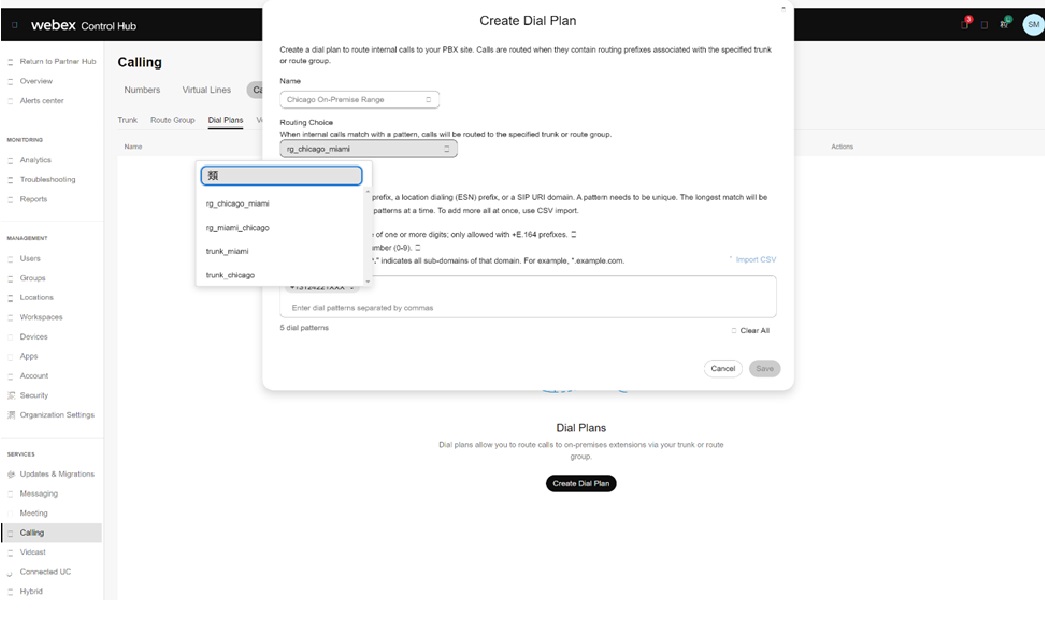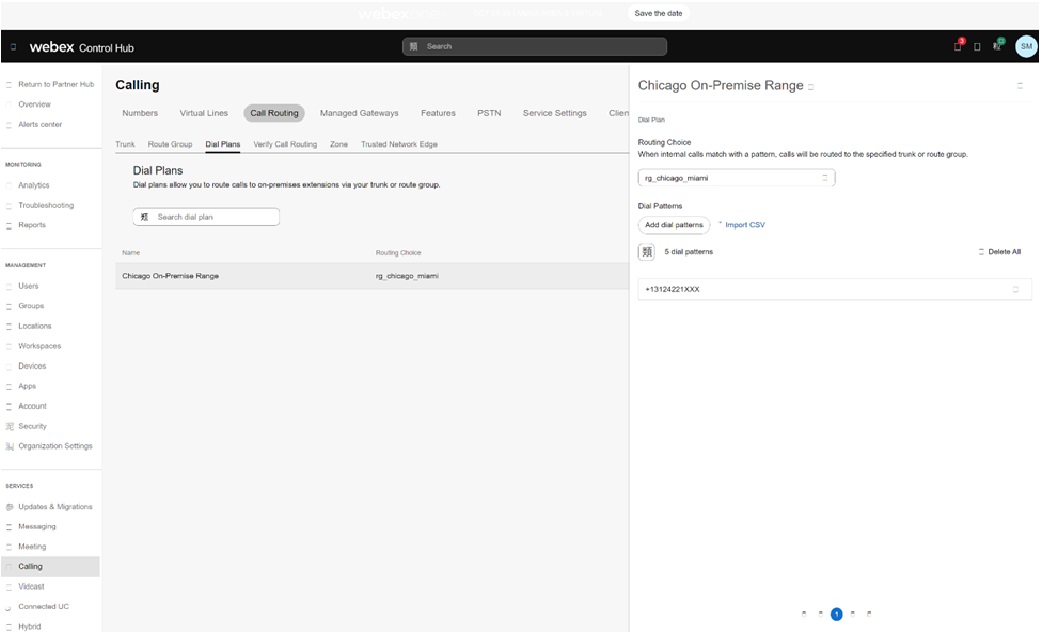- Home
- /
- Articolo




Configurazione di un gateway ospitato da partner
 In questo articolo
In questo articolo Feedback?
Feedback?Queste istruzioni sono per i partner che intendono ospitare un gateway. Leggere per comprendere le best practice e le raccomandazioni.
Webex Calling consente a un cliente di configurare un trunk del gateway locale per inviare e ricevere una chiamata PSTN. Se un partner organizza trunk di diversi clienti, si consiglia di impostare un gateway condiviso per questi trunk.
Questo documento delinea uno schema di alto livello per l'implementazione di un gateway ospitato da partner e si concentra sul trunking basato su certificati. Il modello basato sulla registrazione è un modello semplice da utilizzare per un gateway ospitato da partner che fornisce una soluzione per trunk con capacità ridotta. Questa soluzione possiede limitazioni tecniche intrinseche per trunk ad alta capacità, in particolare per il modello di condivisione del traffico e della connessione basato su TCP. Il motivo principale per la creazione del trunking basato su certificato è quello di risolvere le limitazioni di scala del modello basato sulla registrazione.
La procedura per la creazione del trunk e la configurazione del gateway è simile al gateway locale ospitato dal cliente. Per informazioni dettagliate, vedere: Introduzione al gateway locale
Considerazioni per la distribuzione
Prendiamo in considerazione un ipotetico partner Webex denominato TelSP per illustrare i diversi modelli di distribuzioni che il partner può adottare.
Ecco le specifiche e i requisiti di alto livello di TelSP:
-
Il partner prevede di utilizzare
sip.telsp.comcome dominio di primo livello condiviso tra tutti i clienti che gestisce. -
Il partner possiede
sip.telsp.come può amministrare l'infrastruttura DNS e le autorità di certificazione, gestire gli indirizzi DNS e firmare i certificati per questo dominio e i relativi domini secondari. -
Il partner può distribuire due controller di bordo sessione distinti (fisici o virtuali) come gateway locali per l'accesso PSTN condiviso tra i clienti finali.
-
Il partner dispone di due siti fisici ed entrambi condividono la connettività PSTN:
-
Miami
-
Chicago
-
-
TelSP gestisce i gateway locali per conto dei due clienti CustA e CustB, come di seguito definiti.
In questo articolo, il termine partner si riferisce al partner Webex che gestisce, in particolare TelSP in questo esempio. Questa entità dispone dell'accesso a Webex partner hub.
| Posizione | CustA | Cliente B |
|---|---|---|
|
Posizioni che utilizzano il gateway Miami come destinazione PSTN principale |
Denver |
Dallas |
|
Posizioni che utilizzano il gateway di Chicago come destinazione PSTN principale |
Detroit |
Boston |
|
Sottodominio scelto per un cliente | custa.sip.telsp.com | custb.sip.telsp.com |
Lo scenario desiderato è avere l'origination/terminazione PSTN per entrambi i clienti che utilizzano i gateway di Miami e Chicago forniti dal partner, come mostrato nell'illustrazione:
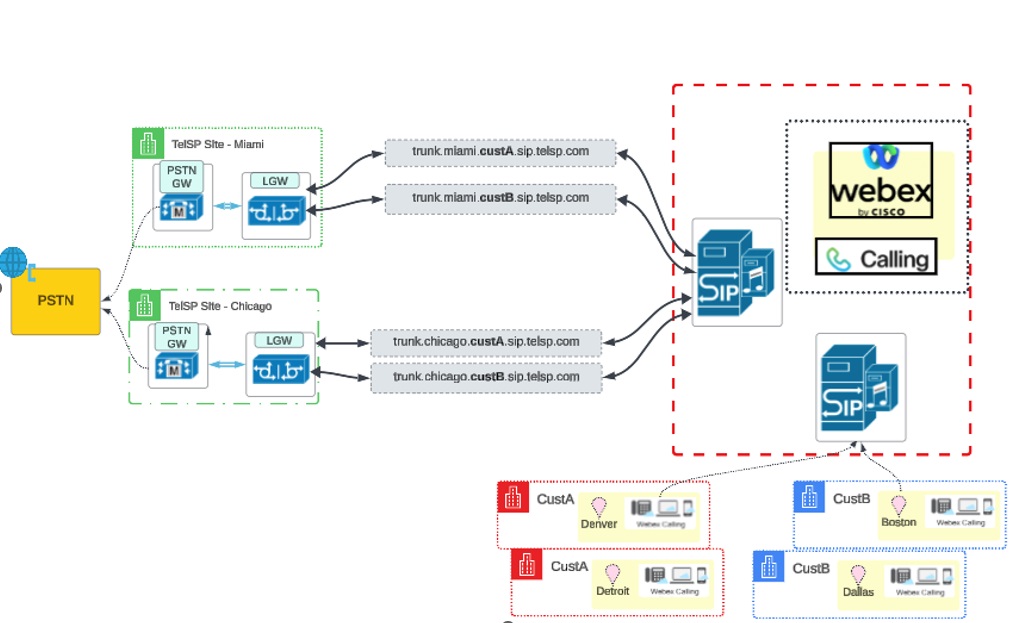
Associazione della posizione del cliente a trunk e gateway
Webex Calling consente la creazione di trunk e la condivisione di un trunk tra più posizioni. Quando si crea il trunk, associare il trunk a una posizione.
Per CustA, i dettagli del trunk sono i seguenti:
| Nome trunk | nome di dominio completo | Posizione associata nella definizione trunk |
|---|---|---|
| trunk_miami | trunk.miami.custa.sip.telsp.com | Denver |
| trunk_chicago | trunk.chicago.custa.sip.telsp.com | Detroit |
La figura mostra l'associazione della posizione del cliente a gateway e trunk per CustA:
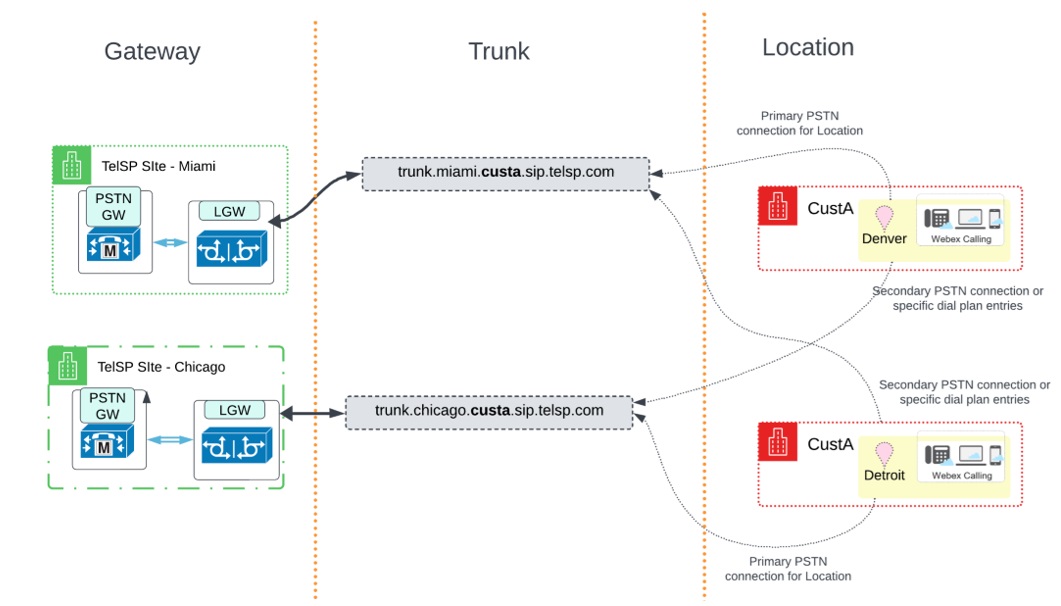
In questa distribuzione, il trunk associato alla posizione è la connessione PSTN principale per tale posizione. L'altro trunk viene utilizzato come connessione PSTN secondaria o come indirizzamento per voci specifiche del piano di numerazione. L'implementazione del rapporto di connessione PSTN principale e secondario avviene attraverso un concetto di gruppo di indirizzamento. Per informazioni dettagliate, vedere la sezione Impostazione cliente Webex .
Per CustB, viene creata un'impostazione simile con i seguenti trunk:
| Nome trunk | nome di dominio completo | Posizione associata nella definizione trunk |
|---|---|---|
| trunk_miami | trunk.miami.custb.sip.telsp.com |
Dallas |
| trunk_chicago | trunk.chicago.custb.sip.telsp.com |
Boston |
La figura mostra l'associazione della posizione del cliente a gateway e trunk per CustB:
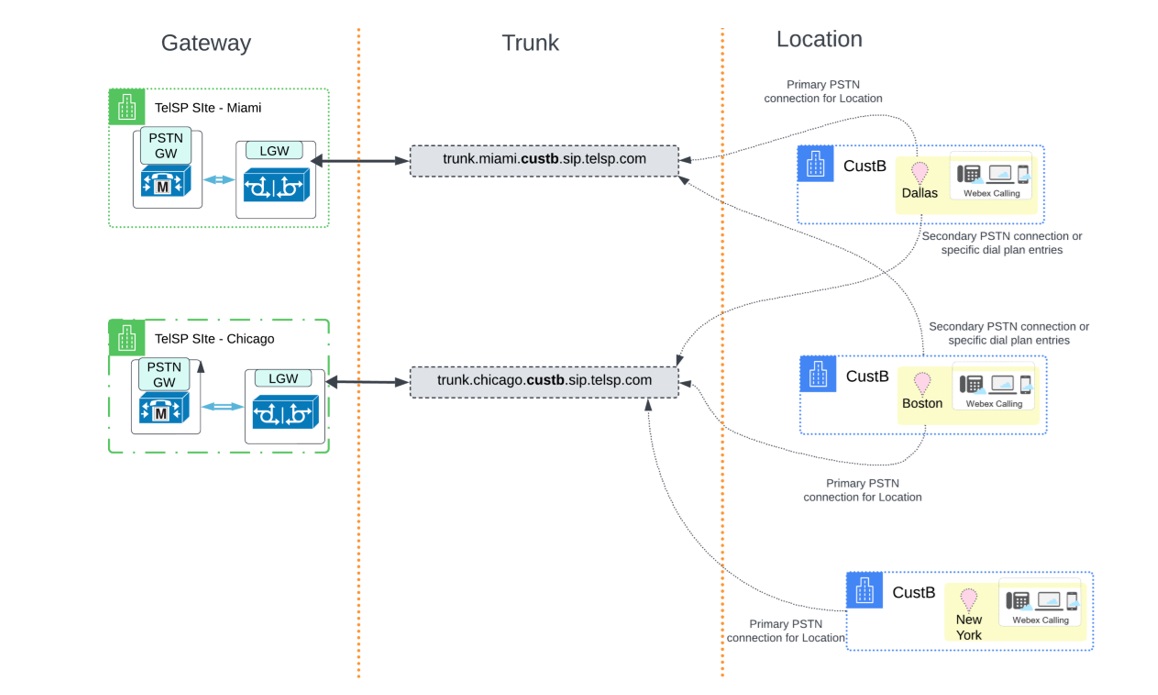
L'illustrazione mostra una terza posizione, ovvero New York, che è possibile aggiungere successivamente e puntare al trunk_chicago trunk come connessione PSTN principale.
Requisiti per configurare l'indirizzo IP
Quando si distribuisce un gateway locale che condivide più trunk, Cisco RICHIEDE l'uso di un nome di dominio completo per trunk. Vedi Configurazione trunk, gruppi di indirizzamento e piani di chiamata per Webex-Calling per dettagli.
Utilizzare un indirizzo IP e una porta ben nota per trunk è la scelta ideale. Tuttavia, l'acquisizione di un indirizzo IPv4 pubblico può essere difficile per alcuni partner che desiderano utilizzare un indirizzo per gateway per sito.
Leggete quindi questi importanti consigli:
-
Cisco non richiede un indirizzo IP per trunk.
-
Un indirizzo trunk può essere risolto con un indirizzo IP univoco o con l'indirizzo condiviso tra un altro trunk.
-
Cisco consiglia di disporre di una porta di ascolto univoca per trunk per i seguenti motivi:
-
Fornisce l'isolamento del livello di rete tra i clienti
-
È tipico dei controller di bordo sessione riutilizzare la connessione socket TCP effimera a meno che non sia previsto l'isolamento come tenant univoco partizionato da un indirizzo IP o da una porta di ascolto univoca per il tenant.
-
La connessione o le connessioni per trunk attraverso l'isolamento del tenant forniscono una produttività migliore in condizioni di rete con un'elevata perdita di dati. Pertanto, il traffico da un cliente non influisce sull'altro.
-
Indirizzo IP per gateway: Configurazione trunk e raccomandazioni
Fare riferimento a questi esempi di diversi modelli di pianificazione:
Modello 1: Indirizzo IP univoco per trunk
In questo modello, tutti i trunk ospitati da entrambi i gateway risolvono in un indirizzo IP univoco e ciascuno di questi trunk può utilizzare o meno la stessa porta, ma idealmente la stessa porta.
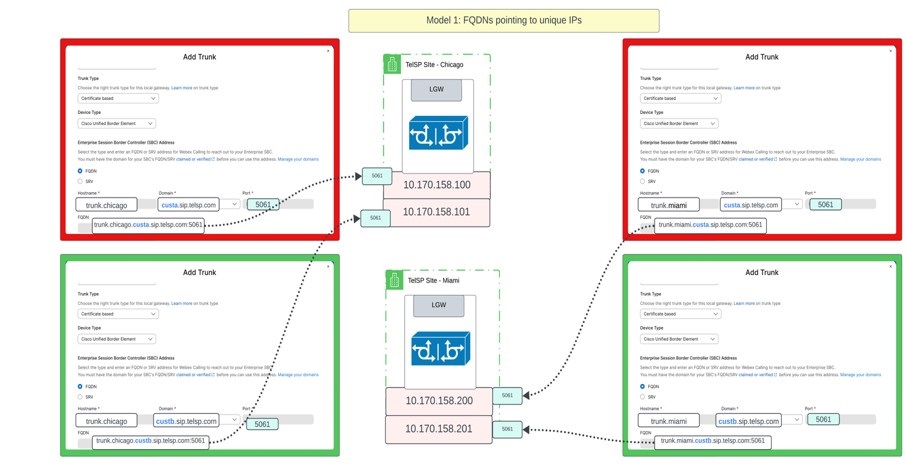
Rappresentare le informazioni in un formato tabulare:
| Indirizzo trunk (FQDN) | Indirizzo IP | Porta |
|---|---|---|
| trunk.miami.custa.sip.telsp.com | 10.170.158.200 | 5061 |
| trunk.miami.custb.sip.telsp.com | 10.170.158.201 | 5061 |
| trunk.chicago.custa.sip.telsp.com | 10.170.158.100 | 5061 |
| trunk.chicago.custb.sip.telsp.com | 10.170.158.101 | 5061 |
Nello stesso modello, il partner può utilizzare un indirizzo SRV. Webex Calling consente solo "_sips._tcp" come combinazione di servizio e protocollo per rilevare l'indirizzo peer se si tratta di un record SRV.
| Indirizzo trunk (SRV) | Indirizzo SRV | Un record | Indirizzo IP | Porta |
|---|---|---|---|---|
| trunk.miami.custa.sip.telsp.com | _sips._tcp.trunk.miami.custa.sip.telsp.com | miami.custa.sip.telsp.com | 10.170.158.200 | 5061 |
| trunk.miami.custb.sip.telsp.com | _sips._tcp.trunk.miami.custb.sip.telsp.com | miami.custb.sip.telsp.com | 10.170.158.201 | 5061 |
| trunk.chicago.custa.sip.telsp.com | _sips._tcp.trunk.chicago.custa.sip.telsp.com | chicago.custa.sip.telsp.com | 10.170.158.100 | 5061 |
| trunk.chicago.custb.sip.telsp.com | _sips._tcp.trunk.chicago.custb.sip.telsp.com | chicago.custb.sip.telsp.com | 10.170.158.101 | 5061 |
Un esempio di come si risolve un record SRV
nslookup -type=srv _sips._tcp.trunk.miami.custa.sip.telsp.com Server: 8.8.8.8 Indirizzo: 8.8.8.8#53 Risposta non autorevole: _sips._tcp.trunk.miami.custa.sip.telsp.com = 3600 50 5061 miami.custa.sip.telsp.com Modello 2: IP condiviso su un gateway ma porte di ascolto diverse
In questo modello, tutti i trunk ospitati sul gateway locale di Chicago vengono risolti nello stesso indirizzo IP e tutti i trunk ospitati sul gateway locale di Miami vengono risolti in un indirizzo IP diverso. Tuttavia, quando si utilizza lo stesso IP, ogni trunk viene configurato utilizzando un nome di dominio completo nell'hub di controllo ed è configurato con una porta univoca.
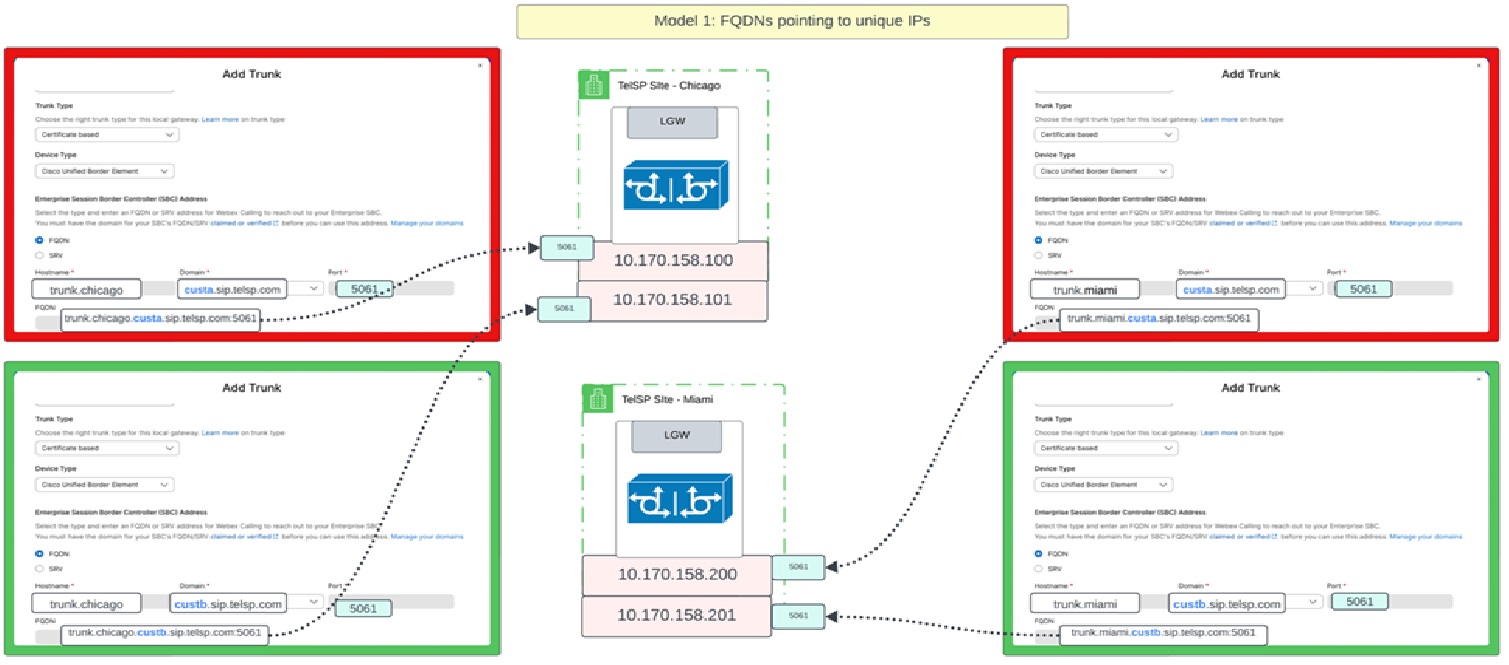
| Indirizzo trunk | Indirizzo IP | Porta |
|---|---|---|
| trunk.miami.custa.sip.telsp.com | 10.170.158.200 | 5061 |
| trunk.miami.custb.sip.telsp.com | 10.170.158.200 | 5062 |
| trunk.chicago.custa.sip.telsp.com | 10.170.158.100 | 5061 |
| trunk.chicago.custb.sip.telsp.com | 10.170.158.100 | 5062 |
Nello stesso modello, il partner utilizza un indirizzo SRV. Webex Calling consente solo "_sips._tcp" come combinazione di servizio e protocollo per rilevare l'indirizzo peer se si tratta di un record SRV.
| Indirizzo trunk (SRV) | Indirizzo SRV | Un record | Indirizzo IP | Porta |
|---|---|---|---|---|
| trunk.miami.custa.sip.telsp.com | _sips._tcp.trunk.miami.custa.sip.telsp.com | miami.sip.telsp.com | 10.170.158.200 | 5061 |
| trunk.miami.custb.sip.telsp.com | _sips._tcp.trunk.miami.custb.sip.telsp.com | miami.sip.telsp.com | 10.170.158.200 | 5062 |
| trunk.chicago.custa.sip.telsp.com | _sips._tcp.trunk.chicago.custa.sip.telsp.com | chicago.sip.telsp.com | 10.170.158.100 | 5061 |
| trunk.chicago.custb.sip.telsp.com | _sips._tcp.trunk.chicago.custb.sip.telsp.com | chicago.sip.telsp.com | 10.170.158.100 | 5062 |
Un altro esempio di come viene risolto un record SRV è il seguente. In questo esempio, esiste 1 record per indirizzo IP. Tuttavia, la porta è univoca per indirizzo ed è rappresentata attraverso una configurazione DNS specifica che collega un indirizzo SRV alla porta giusta.
nslookup -type=srv _sips._tcp.trunk.miami.custa.sip.telsp.com Server: 8.8.8.8 Indirizzo: 8.8.8.8#53 Risposta non autorevole: _sips._tcp.trunk.miami.custa.sip.telsp.com = 3600 50 5061 miami.sip.telsp.com nslookup -type=srv _sips._tcp.trunk.miami.custb.sip.telsp.com Server: 8.8.8.8 Indirizzo: 8.8.8.8#53 Risposta non autorevole: _sips._tcp.trunk.miami.custb.sip.telsp.com = 3600 50 5062 miami.sip.telsp.com Impostare un server di dominio e generare il certificato
Il partner possiede telsp.com e i suoi sottodomini. Pertanto, il server DNS e l'autorità di ottenere i certificati firmati da un'autorità di certificazione approvata sono di competenza del partner.
-
Cisco Webex prevede che il partner pubblichi l'indirizzo FQDN o SRV, inclusi i record A nel dominio pubblico.
-
Cisco Webex prevede che il partner utilizzi una delle autorità di certificazione elencate come pubblicato in questo documento.
Quando si utilizza un nome di dominio completo come indirizzo del trunk, impostare i certificati firmati con il nome comune (CN) o il numero alternativo dell'oggetto (SAN) impostati sui nomi di dominio completo per i trunk.
| Gateway ospitato da partner | Cliente | Indirizzo trunk | Certificato CN/SAN |
|---|---|---|---|
| Miami | CustA | trunk.miami.custa.sip.telsp.com | trunk.miami.custa.sip.telsp.com |
| Cliente B | trunk.miami.custb.sip.telsp.com | trunk.miami.custb.sip.telsp.com | |
| Chicago | CustA | trunk.chicago.custa.sip.telsp.com | trunk.chicago.custa.sip.telsp.com |
| Cliente B | trunk.chicago.custa.sip.telsp.com | trunk.chicago.custa.sip.telsp.com |
Utilizzare uno di questi metodi per generare i nomi di dominio completi nel certificato:
-
Scegliere uno dei nomi di dominio completo come nome comune (CN) e il resto come numero alternativo del soggetto (SAN).
-
Posizionare il dominio di primo livello (sip.telsp.com) come CN e tutti i nomi di domini completi come SAN.
In futuro, sarà possibile convalidare il certificato in base al dominio di primo livello appropriato da questa configurazione.
Quando si utilizza un SRV come indirizzo del trunk, impostare i certificati firmati con il CN o SAN nella parte host dell'indirizzo SRV. Il Record A o il CNAME in cui viene risolto l'indirizzo SRV non è richiesto.
| Gateway ospitato da partner | Cliente | Indirizzo trunk | indirizzo SRV | Certificato CN/SAN |
|---|---|---|---|---|
| Miami | CustA | trunk.miami.custa.sip.telsp.com | _sips._tcp.trunk.miami.custa.sip.telsp.com | trunk.miami.custa.sip.telsp.com |
| Cliente B | trunk.miami.custb.sip.telsp.com | _sips._tcp.trunk.miami.custb.sip.telsp.com | trunk.miami.custb.sip.telsp.com | |
| Chicago | CustA | trunk.chicago.custa.sip.telsp.com | _sips._tcp.trunk.chicago.custa.sip.telsp.com | trunk.chicago.custa.sip.telsp.com |
| Cliente B | trunk.chicago.custb.sip.telsp.com | _sips._tcp.trunk.chicago.custb.sip.telsp.com | trunk.chicago.custb.sip.telsp.com |
Impostazione del gateway
Utilizzare queste risorse per impostare un gateway locale.
Per impostare Cisco CUBE, utilizzare questa procedura: Configurazione del gateway locale su Cisco IOS XE per Webex Calling
È possibile impostare SBC di terze parti approvati, vedere: Introduzione al gateway locale
Impostare il gateway ospitato dal partner in conformità alle seguenti linee guida: Introduzione al gateway locale
Impostare ciascun trunk in base alle istruzioni pertinenti per il dispositivo SBC. Per le istruzioni di Cisco CUBE, vedere: Configurazione del gateway locale su Cisco IOS XE per Webex Calling
Imposta classi vocali, componi peer e componi peer group per il traffico in ingresso e in uscita per il trunk in base all'immagine: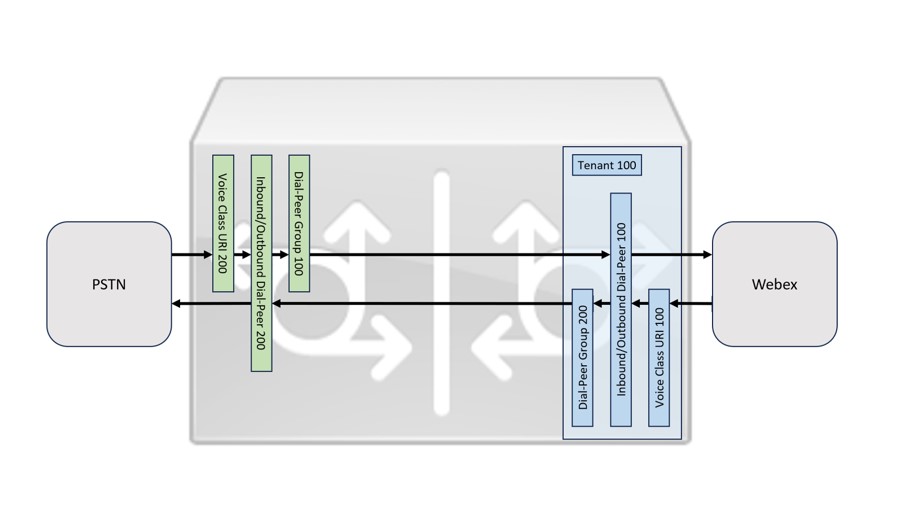
Configurazione dei trunk del gateway in Control Hub
Da Partner Hub, puoi avviare Control Hub per CustA o CustB e configurare il gateway. Utilizzare questa procedura per configurare per ciascun cliente:
- Crea trunk: aggiungi un trunk in Calling/Call Routing/Trunk per ciascun gateway condiviso del partner. Per impostare un trunk, vedi Configurazione di trunk, gruppi di indirizzamento e piani di chiamata per Webex Calling
-
Aggiungi un dominio e verifica: aggiungi e verifica il seguente dominio utilizzato per creare un trunk in Impostazioni/Domini gestione/organizzazione.
CustA Cliente B sip.telsp.com sip.telsp.com Quando si aggiunge un dominio, viene generato e posizionato un token nel record TXT per il dominio nel server DNS del partner. Questo record consente a Control Hub di verificare che il dominio sia di proprietà del partner. Per informazioni dettagliate, vedi Gestione dei domini
Poiché Il dominio comune viene utilizzato per la verifica su ciascun cliente. Tuttavia, poiché questa verifica si verifica a livello di organizzazione cliente, assicurarsi che venga generato e utilizzato un token diverso per la verifica su ciascuna organizzazione cliente. Poiché un singolo dominio viene utilizzato tra le organizzazioni dei clienti, qualsiasi organizzazione non può richiedere la proprietà del dominio. - Imposta indirizzo SBC con FQDN—
Per il gateway di Miami:
Parametro CustA Cliente B Posizione Denver Boston Nome trunk trunk_miami trunk_miami Tipo di trunk Basato su certificato Basato su certificato Tipo di dispositivo ad esempio Cisco Unified Border Element (o un altro dispositivo supportato) ad esempio Cisco Unified Border Element (o un altro dispositivo supportato) Tipo di indirizzo SBC nome di dominio completo nome di dominio completo Nome host trunk.miami.custa trunk.miami.custb Dominio sip.telsp.com sip.telsp.com Porta 5061 5062 nome di dominio completo trunk.miami.custa.sip.telsp.com:5061 trunk.miami.custb.sip.telsp.com:5062 Numero massimo di chiamate simultanee (250-6500) 500 500 Per il gateway di Chicago:
Parametro CustA Cliente B Posizione Detroit Dallas Nome trunk trunk_chicago trunk_chicago Tipo di trunk Basato su certificato Basato su certificato Tipo di dispositivo ad esempio Cisco Unified Border Element (o un altro dispositivo supportato) ad esempio Cisco Unified Border Element (o un altro dispositivo supportato) Tipo di indirizzo SBC nome di dominio completo nome di dominio completo Nome host trunk.chicago.custa trunk.chicago.custb Dominio sip.telsp.com sip.telsp.com Porta 5061 5062 nome di dominio completo trunk.chicago.custa.sip.telsp.com:5061 trunk.chicago.custb.sip.telsp.com:5062 Numero massimo di chiamate simultanee (250-6500) 500 500 -
(Opzionale) Non disponi di un nome univoco per il trunk tra i clienti e lo stesso nome può aiutare a monitorare il trunk.
-
Alcuni SBC consentono di configurare la stessa porta, ma questa configurazione può avere un impatto sulla capacità. Pertanto, utilizzare porte diverse.
-
- Uso di trunk: scegliere qualsiasi posizione arbitraria per il trunk a causa di quanto segue:
-
Qualsiasi posizione può utilizzare il trunk in una connessione PSTN.
-
Puoi accedere al trunk attraverso un gruppo di indirizzamento.
-
Qualsiasi piano di chiamata può utilizzare il trunk.
-
Vedi le definizioni del trunk con le posizioni associate:
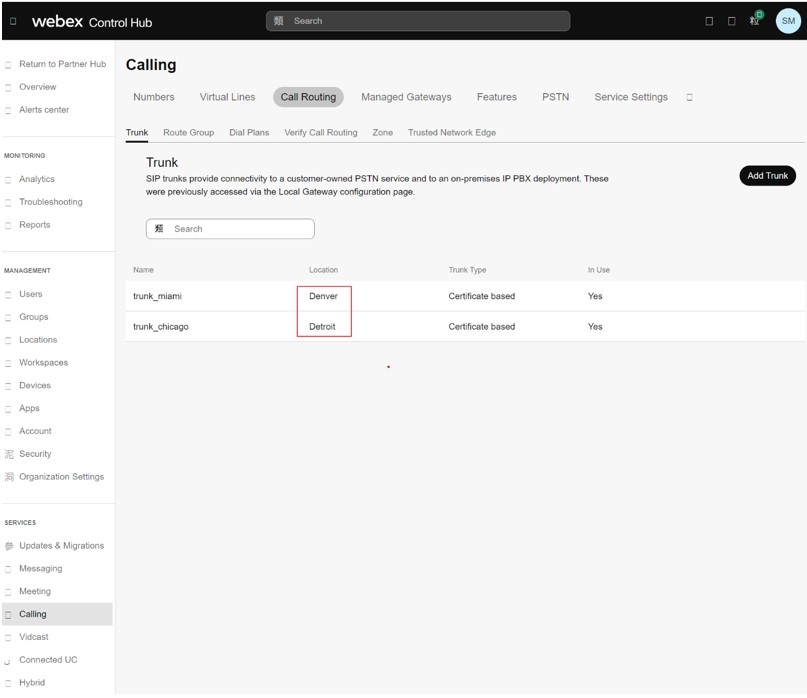
Puoi utilizzare questi trunk per creare gruppi di indirizzamento. Nell'immagine, rg_miami_chicago è definito un gruppo di indirizzamento che indirizza le chiamate al trunk_miami trunk come opzione principale e al trunk_chicago trunk come opzione secondaria.
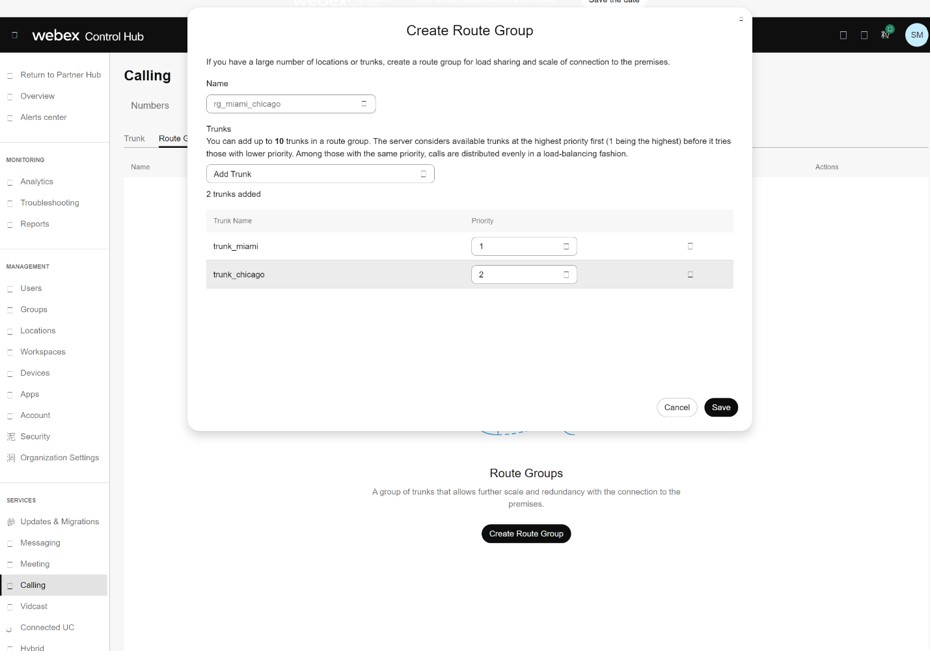
È possibile definire un secondo gruppo di indirizzamento rg_chicago_miami che indirizza le chiamate al trunk_chicago trunk come opzione principale e al trunk_miami trunk come opzione secondaria.
-
I trunk e i gruppi di indirizzamento definiti sono ora disponibili nell'opzione PSTN Calling Connection per ciascuna posizione. Nell'immagine, vedere la posizione di Denver.
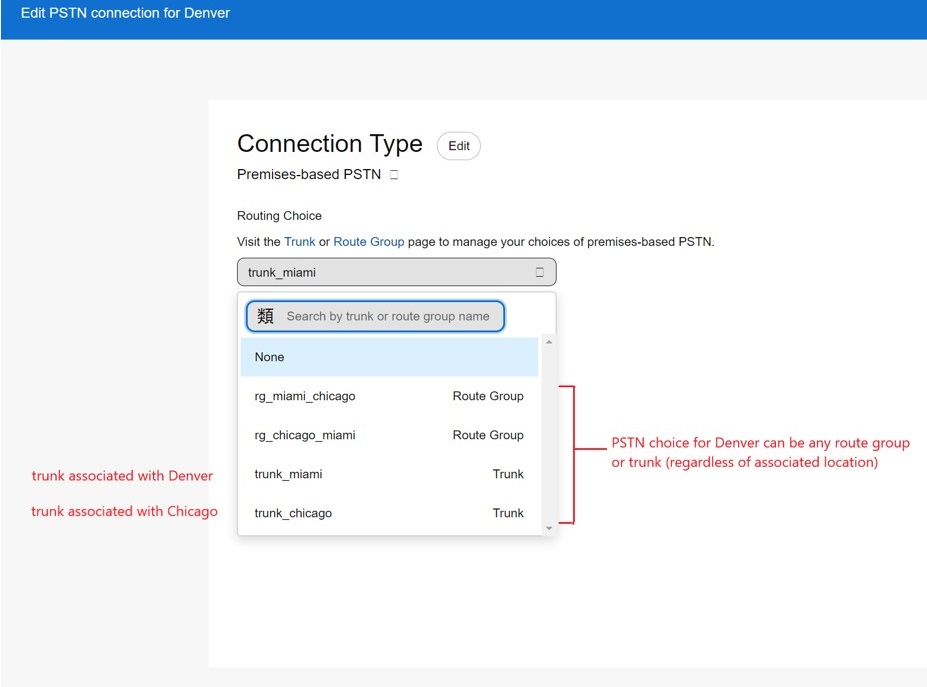
-
È possibile utilizzare i trunk e i gruppi di indirizzamento nella definizione del piano di chiamata. Ad esempio, un intervallo di numeri locali a Chicago per il cliente viene suddiviso in modo da terminarlo al rg_chicago_miami gruppo di indirizzamento (per tutte le posizioni) nell'immagine:
